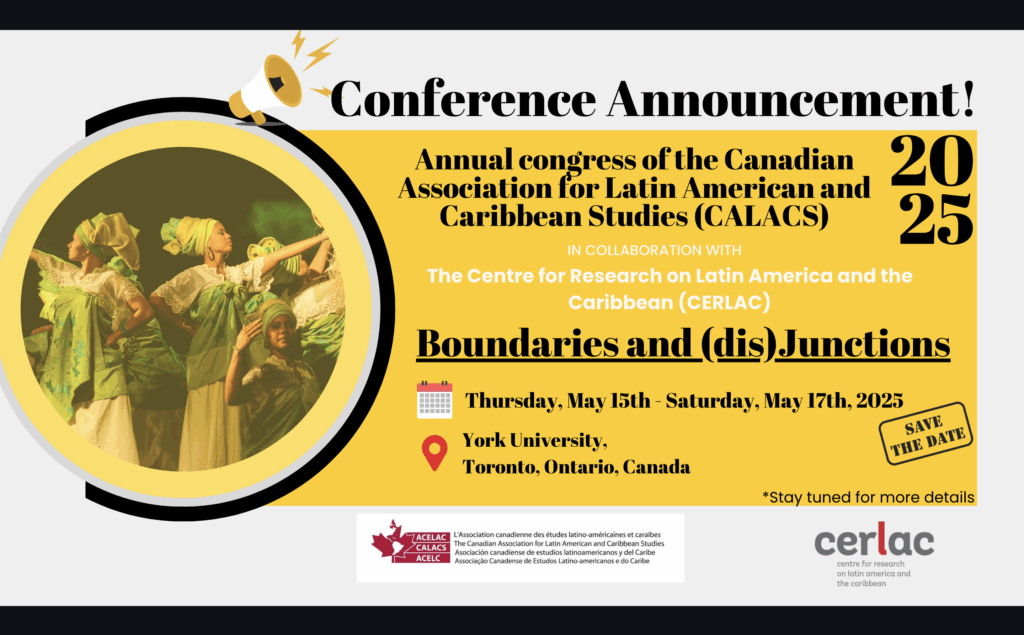cMAS and MCL members @ Boundaries and (dis)junctions CALACS Congress 2025
From May 15 to May 17, 2025, members of cMAS and MCL will participate in the Annual Congress of the Canadian Association for Latin American and Caribbean Studies (CALACS), 2025 at York University, Toronto, as part of the panel “Negotiating Representation: Critical Analyses of Media-arts and Cultural Practices across the Americas” organized and chaired by PhD Candidate Gabriel Juliano.
With presentations from MA Alumna, Maira Cristina Castro Mina, PhD candidates Hamed Rashtian, Tylar Campbell and Juliano, the panel explores how media-arts and cultural practices across the Americas challenge hegemonic narratives and redefine representations of identity, history, and power. By drawing from approaches such as cultural studies, decolonial theory, and feminist methodologies, it highlights how marginalized communities and artists reclaim cultural symbols, maintain practices, and use media as tools to confront hegemonic narratives, promoting empowerment and social transformation.
The papers include:
The ‘Villain’ Archetype: an Empowerment Sign in Brazilian Popular Culture by Gabriel Juliano
According to Roland Barthes, cultural artifacts can be interpreted on the mythological level (connotative, rhetorical qualities). Myths, which construct hegemonic truths, are perpetuated through media and culture. However, popular culture, being rooted in the social meaning produced by its creators, often challenges dominant ideologies. Popular texts are shaped by the tension and interplay between forces of domination and their own appeal to the masses (Fiske 2010, 04). Cultural production by marginalized groups can reinterpret forms of social memory and re-signify history by asserting their aesthetics and affirming their space (Chaui 2021, 9).
Using this framework as a lens, I analyze the single Vilão da Mídia (2024) and music album Só Vilão, Aqui Não Tem Herói (2024) by the Brazilian rapper Kyan to explore how Brazilian hip-hop reimagines the ‘villain’ archetype—historically a tool of oppression—as a symbol of empowerment. To conduct this analysis, I employ critical media analysis (Mitchell and Hansen 2010), supported by cultural studies (Hall 1992), STS (Bauchspies et al. 2006), and decolonial theories (Mignolo 2020; Tuck 2009). This approach enables me to dissect the content of these popular culture media artifacts and examine their ideological, technological, cultural, and social contexts, ultimately arguing for their transformative and empowering qualities.
Beyond Representation: Fostering Deeper Understanding Through Opaque Imagery in a Politicized Global Environment by Hamed Rashtian
Édouard Glissant introduces the concept of “opacity” as a fundamental right, arguing that embracing opacity is essential for preserving the intrinsic complexities of cultures without simplifying them. Drawing on Glissant’s ideas, this paper examines the media art installation The Eyes of Gutete Emerita (1996) by Chilean American artist, Alfredo Jaar, to explore how the artist employs non-representational methods to depict past events. These methods respect the opacity of the depicted subjects and allude to the impossibility of fully representing past realities without reducing them. Furthermore, I frame Jaar’s artwork through Laura Marks’ concept of the “haptic image,” which, I argue, aligns with Glissant’s notion of opacity.
Using the theoretical framework developed in this paper and the analysis of Jaar’s methods for creating opaque images, I extend this discussion to analyze Nervus Rerum (2008) by the Otolith Group and Restaged (2011) by Joana Hadjithomas and Khalil Joreige. Jaar’s methods serve as a model for understanding how these two art projects incorporate non-representational and opaque approaches in their creation. I will examine how these approaches respect their subjects, trigger viewers’ imaginations, and evoke the fugitivity of the past, while employing diverse aesthetic strategies to challenge the colonization of images, potentially fostering social change and mobilizing action.
Digital Media and Matrilineal Knowledge Transmission in Racialized Communities: A Feminist Collaborative Approach by Maira Cristina Castro
This presentation explores the role of digital media in facilitating matrilineal knowledge transmission within Black and Indigenous communities in Colombia. Drawing on my experimental documentary work with Colombian artisanal gold miners, known as the Tambadoras (2022), I examine how digital platforms can support traditional knowledge-sharing practices. The Tambadoras project not only documented cultural expressions but also highlighted the potential of digital tools to preserve intangible heritage. Building on this foundation, I review the literature on digital media’s impact on matrilineal knowledge transmission, identifying opportunities for digital interventions to enhance intergenerational communication and learning. The discussion will extend to Gabriela Aceves-Sepúlveda’s theory of “Feminist Collaborative Re-activation,” which argues for the use of unconventional archives and arts-based practices to foster intergenerational participation and historical memory. By examining how these practices can re-activate forgotten or overlooked histories, I argue for their transformative potential in sustaining cultural heritage and advancing feminist methodologies in knowledge production.
This presentation will detail the theoretical underpinnings of feminist collaborative archival practices and the potential of digital media as a transformative tool for community empowerment and historical engagement.
Soundcestral Remembrance: African Diasporic Drumming Traditions as Cultural Memory and Resistance in New Orleans and Uruguay by Tylar Campbell
This research examines how African diasporic communities in New Orleans and Uruguay preserve and transmit cultural knowledge through drumming traditions. Drawing on ethnographic fieldwork and historical research of Trans-Atlantic Slavery, I introduce the framework of ‘Soundcestral remembrance’ to explore how sounds and rhythms carry cultural memory across generations. Through visual ethnography and audio documentation, and building on Fred Moten’s theory of Black fugitivity and Katherine McKittrick’s ‘Black Geographies,’ I demonstrate how these drumming practices serve as spaces of resistance while uniting communities and maintaining vital connections to African heritage. This comparative analysis reveals how cultural traditions both honor their origins and adapt within contemporary contexts.
This presentation explores the intersection of rhythmic dialogue through multimodal narrative anthropology, contributing to overlapping fields of history, anthropology, and digital humanities.

